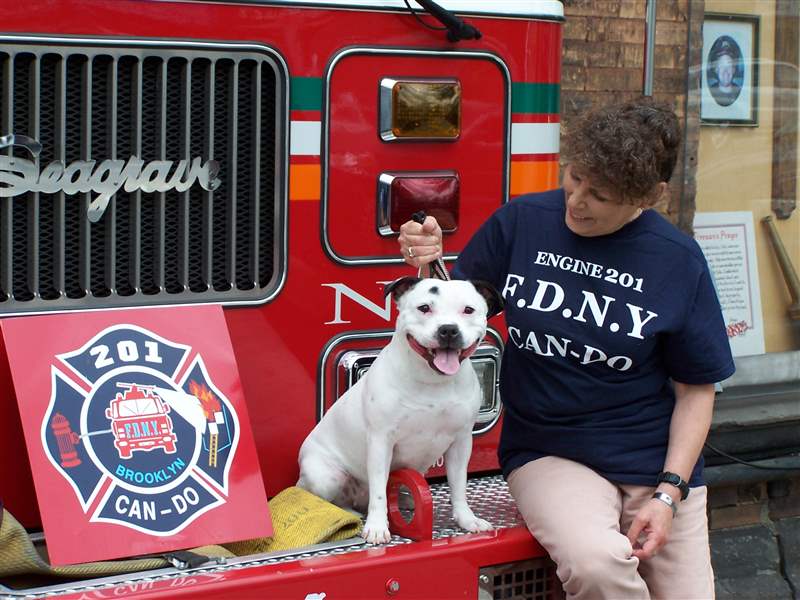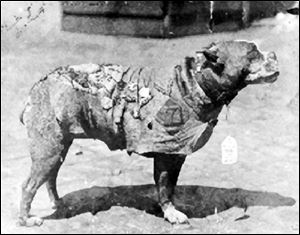Advocates praise qualities of 'pit bulls'
12/6/2009
Staffordshire terrier advocate Ann Lettis shows 'Can Do,' named for the motto of Brooklyn Engine Co. 201, which lost a lieutenant Sept. 11, 2001. His sister owns the dog with Ms. Lettis.
NOT BLADE PHOTO

Staffordshire terrier advocate Ann Lettis shows 'Can Do,' named for the motto of Brooklyn Engine Co. 201, which lost a lieutenant Sept. 11, 2001. His sister owns the dog with Ms. Lettis.
COLUMBUS - The idea that Ohio might consider her champion Staffordshire bull terrier to be a "vicious dog" seems unfathomable to Ann Lettis.
"This breed in particular is called the nanny dog in England because it has a natural love of children," said the Staten Island, N.Y., resident who has shown Staffordshire bull terriers and American Staffordshire terriers in dog shows and starred with one of her pets in an American Dog Kennel safety video aimed at children.
"I would be at a show, and if [Champion Mirkwood Extreme Obsession] saw a child, he would start making weird sounds in his throat," she said. "I would have to ask the child to come over and say hello because he would be upset when he saw a child who didn't want to come over and say hello to him."
But because of their appearance, both terrier breeds could fall under the general term of "pit bull" in Ohio's dog law. And in Lucas County, based on the policies of outgoing Dog Warden Tom Skeldon, Ms. Lettis' purebred show dogs would be killed after three days if they were picked up running loose in Toledo without licenses.
Staffordshire terriers are one of several breeds Mr. Skeldon classifies as vicious "pit bulls" - dogs he has been killing by the hundreds each year for the past two decades.
Ohio is the only state to automatically deem a "pit bull" vicious, subjecting them to additional muzzling, confinement, and liability insurance requirements.
"Unfortunately, anything with short hair is called a pit bull," Ms. Lettis said.

Sergeant Stubby, a 'pit bull' terrier, was the most decorated dog of World War I. His accomplishments included alerting soldiers in Europe to mustard-gas attacks and locating wounded men.
Ryan O'Meara, a former dog trainer, is publisher of the United Kingdom's largest dog publication, K-9 Magazine.
Although he, like Ms. Lettis, finds the idea of a dog being deemed inherently vicious to be absurd, he was in the middle of a media firestorm last week after an "American pit bull" mauled and killed a 4-year-old boy. Since 1991, the U.K.'s Dangerous Dog Act has banned the "pit bull type" from the country. Owners of such a dog could be prosecuted and the dog confiscated. If the dog fails a temperament test, it could be euthanized.
Mr. O'Meara acknowledged that the breed-specific designation probably won't be lifted anytime soon.
"It's not a vote winner," he said. "It would be a very brave politician who will stand up and make this argument, certainly in the wake of a death. The law fails to acknowledge that banning anything will make it more attractive to the exact demographic you want to keep away from it.''
The attack on the boy occurred even though the dog was already illegal in the country. The dog's owner, the boy's uncle, has been charged with manslaughter. The animal was shot by police.
Ohio's 22-year-old dangerous-dog law defines a "vicious dog" to be one that has killed or seriously injured another person, has killed another dog, or belongs to a breed "commonly known as a pit bull dog."
The United Kingdom, however, bans not only the "pit bull type," but also the Dogo Argentina, the Japanese Tosa, and the Fila Brasileiro, all breeds with some reputation for being trained as fighters or as guards. According to Mr. O'Meara, the other breeds never had much of a presence in the United Kingdom.
Specific recognized breeds such as the Staffordshire bull terrier and American Staffordshire terrier, close relatives to the "pit bull," are not specifically outlawed in the United Kingdom. But if they have broad chests and short hair that fit the general perception of a "pit bull type," they can fall under the law, Mr. O'Meara said.
Ms. Lettis, director of the Responsible Dog Owners Association of New York, said the dogs get a bad rap. "I was totally shocked at how easy it was to live with an Amstaff [American Staffordshire terrier] and how easy it was to teach him good manners," she said. "If the Amstaff has one fault, it's that they're so intelligent that they can learn bad as quickly as they learn good. They want to please their owners."
The Amstaff, a breed recognized by the American Kennel Club, competes in such prestigious dog shows as the Westminster Kennel Club show held annually at Madison Square Garden in New York.
"[The Amstaff] is like any dog that is shown here," Westminster spokesman David Frei said. "They're well-trained and under the control of people who consider them to be wonderful, lovable family dogs."
Monique Bertrand, public relations chairman for the Staffordshire Terrier Club of America, noted that New Bedford, Mass., considered a ban for several years.
"Instead, we have a very good dangerous-dog law in place," she said. "They go after the owner. They don't scrutinize whether it's a Chihuahua, German shepherd, or pit bull. The owner is held liable. The owner has to go through an obedience class."
"If dogs are deemed dangerous, they have to be microchipped," she said. "They have to have a secure kennel in the back, and they have to be muzzled when off property and can't be walked by someone under 18. The dog definitely has to show unprovoked aggression toward people."
Cincinnati bans pit bulls, and more often that not, those confiscated through police or the contracted Society for the Prevention of Cruelty to Animals will be euthanized.
Andy Mahlman, director of operations for SPCA Cincinnati, said the local organization opposes breed-specific laws. But the organization has a contract to pick up stray dogs, cats, and other animals and to take possession of dogs that city police identify and confiscate as illegal "pit bulls."
Mr. Mahlman said the SPCA tries to find responsible homes to adopt the pit bulls in other parts of Hamilton County where they are not banned.
But with the city ban and the restrictions placed on ownership of the animals, options are limited.
Of 7,611 dogs confiscated in 2008, 1,207 were pit bulls.
Mr. Mahlman did not cite specific statistics, but he said more often than not, the "pit bulls" were destroyed.
"It we can't find a responsible home for a 'pit bull,' we don't want them to get back in hands of people who abuse or fight them," he said. "In many cases they get a bad rap, but we have a job to do."
"Most of them are great with people, but many are dog aggressive or cat aggressive," he said. "When a dog of that nature gets loose because of a pattern of irresponsibility of the dog owner, some are fine, but others are not. When they do bite, they can cause a nasty wound. By the nature of their jaw structure, they tend to not let go."
Jeff Shaver of Houston, president of the American Rottweiler Association, fears it may be only a matter of time before eyes turn to the Rottweiler. He has owned several and entered them in the Westminster show in the 1990s.
"We're in the same situation as any large breed," he said. "Once states start enacting bans or restricting types of dogs, it spills over into other breeds."
He submitted a friend-of-the-court brief in opposition to Ohio's law in 2007 when the state Supreme Court looked at and ultimately upheld it along with Toledo's companion ordinance.
"On behalf of the 'pit bull,' I've never owned one, but they're not what they're made out to be," he said. "Wrong people have dogs for wrong reasons. The most decorated dog in World War I was a 'pit bull' terrier."
Wounded and gassed in Europe while a mascot with American troops serving with the 102nd Infantry, Sergeant Stubby was credited with alerting soldiers to mustard-gas attacks, locating wounded soldiers on the combat field, and even capturing a German soldier.
Originally sneaked aboard a troop carrier, the Hartford, Conn., dog was made a national celebrity upon his return home. In 1921, Gen. John "Blackjack" Pershing, supreme commander of American forces, pinned a gold hero dog's medal onto Stubby's uniform.